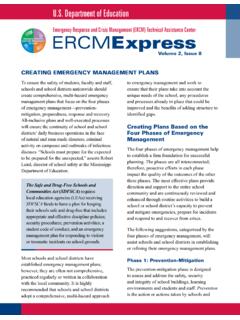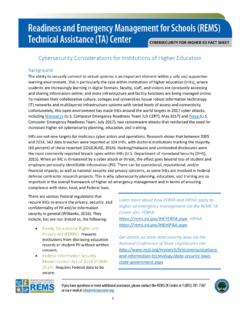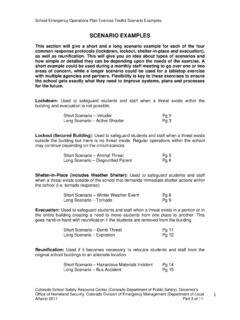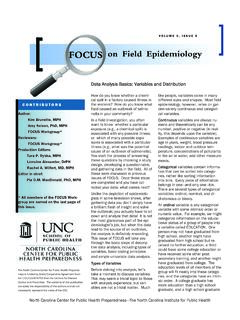Transcription of Six-Step Planning Process for Institutions of Higher Education
1 1 ExpressVolume 5, issue 3, 2014 Six-Step Planning Process for Institutions of Higher Education Providing for the safety and security of a campus and community is complex. The setting and types of people on campus varies on an hourly and daily basis, students live in both on- and off-campus housing, and some Institutions of Higher Education (IHE) have classrooms throughout different regions. For a Higher Education emergency operations plan (EOP) to be effective, it must integrate its strategy for the IHE s main campus, satellites, and individual teaching and learning settings with that for the local community and city. For this reason, it is essential that no one person work alone when writing an EOP for their IHE.
2 Not only is the sole-developer approach stressful and tiresome, it also is ineffective because it leaves out an opportunity to receive critical input from campus, city, and community partners. This includes campus departments, facilities managers, first responders, public health officials, mental health personnel, and additional community partners who should be involved throughout the entire Planning Process . The Higher Education environment is dynamic, unique, and ever-changing. For that reason, the Planning Process should be flexible, adaptable, and inclusive of appropriate stakeholders. The result will be a high-quality EOP. The Federal Guide for Developing High-Quality Emergency Operations Plans for Institutions of Higher Education (IHE Guide) outlines a Six-Step Planning Process that conveys a practical and efficient way to develop an EOP.
3 This REMS Express edition provides a practitioner s perspective on the IHE Guide s recommended Six-Step Planning Process . IHEs may find this Process useful when they are developing a new EOP, performing a comprehensive review of existing plans, or evaluating specific sections of their IHE s EOP on a periodic basis. QUICK LINKSR equest a TrainingRequest TATake a WebinarFind a ResourceTake an Online CourseJoin the Community of PracticeThe REMS TA Center supports schools, school districts, and Institutions of Higher Education in developing and implementing comprehensive emergency operations plans. For additional information about school and Higher Education emergency management topics, visit the REMS TA Center at on next page2 Since campuses are different in size and complexity, the collaborative Planning team may vary according to available personnel and from previous pageSTEP 1: FORM A COLLABORATIVE Planning TEAMT hink for a moment about a large event on your campus that requires several months of coordinated and detailed Planning among many campus departments and first responders.
4 For many IHEs, commencement is such an event. Generally, Planning for it would involve the following: identification of a core Planning team to plan the event; formation of a common framework; assignment of roles and responsibilities; and development of a regular schedule of meetings to adequately plan the event. The development of an EOP involves a very similar Process and should include input from many of the same groups and individuals. EOP Planning teams should be small enough to promote good working relationships, but large enough to fully represent the campus and community. Many campuses even include a student government representative and/or a parent representative from an IHE parents association in their Planning Process .
5 STEP 2: UNDERSTAND THE SITUATIONOnce appropriate members have been considered, the IHE Guide recommends that EOP Planning team members work together to understand the situation on campus. This can be accomplished by identifying specific threats and hazards; assessing risks; and prioritizing the threats and hazards that are identified in your collaborative emergency Planning Process . Many resources are available to support the Planning team in this step. A good initial action for the team is to review institutional data, which should include campus and community crime statistics, risk management information on historical events, and past insurance exposures that have impacted the campus.
6 Equally important, local (county and city) and state emergency management and other public safety agencies can provide a broader perspective on historical threats and hazards that have impacted the county or region. A city or county hazard mitigation plan will provide current and historical threat and hazard data for the local area, including your campus. This information can be extremely useful to Planning teams during the hazard identification Process . Also available are many assessment tools, including site assessments, culture and climate assessments, threat assessments, and capacity assessments. STEP 3: DETERMINE GOALS AND OBJECTIVES Once the Planning team has listed the threats and hazards that will be included in the EOP, goals and objectives should be developed for each threat and hazard.
7 This method may be unique in comparison to what some members of the Planning team are accustomed to using. However, it is a proven community emergency Planning approach that is crucial to success. As used in the Planning context, goals are broad statements that define what personnel are to achieve. The IHE Guide recommends that Planning teams develop at least three goals for each threat or hazard to clarify what should happen before, during, and after each of them. Objectives are specific, measureable actions that help to achieve the goals. In some cases, multiple objectives may support a single goal. Once objectives are defined for all the prioritized threats and hazards, some activities or functions may be observed that apply to more than one threat or hazard.
8 Several of the more common cross-cutting emergency functions that are used in the Higher Education setting include evacuation, medical care, shelter-in-place, and accounting for all persons, a function that involves accounting for the presence and well-being of all students, faculty, and staff. For more information on these emergency functions, which are referred to as functional annexes in the IHE Guide, visit the REMS TA Center website at Continued on next page3 Function: Evacuation(Due to a fire, hazardous materials spill in the school, active shooter situation, roof failure, etc.)OBJECTIVESBEFOREE stablish Evacuation Routes & Assembly AreasIdentify primary and secondary evacuation routesIdentify primary and secondary assembly areasPost evacuation maps in all roomsTrain all students and staffGOALOBJECTIVESAFTERR eestablish Learning EnvironmentReturn to classroomsDebrief, evaluate, and adjust protocolsGOALOBJECTIVESDURINGE vacuate the School ImmediatelyNotify all persons to evacuateAll persons evacuate immediatelyGather at assembly areaAccount for all personsGOALC ontinued from previous pageSTEP 4: PLAN DEVELOPMENT FOR IDENTIFYING COURSES OF ACTIONSTEP 5.
9 PREPARE, REVIEW, AND APPROVE THE PLANIHEs can use scenario-based Planning to envision all the ways a potential emergency could unfold and then plan accordingly by developing courses of action. During the actual plan development phase, courses of action are established to help accomplish the goals and objectives that the Planning team identified in Step 3 of the Planning Process . Courses of action commonly address the questions of what, who, when, where, why, and how for each threat, hazard, and function identified by the Planning team. The courses of action should read as a specific set of steps or instructions that groups and individuals will follow to accomplish the defined goals and objective(s).
10 Generally, such steps would be depict the scenario; determine the amount of time available to respond; identify decision points; and develop courses of action. Once the Planning team has identified all the different ways an emergency could enfold, it should find a way to visually depict the flow. Although this may seem like a difficult task at the onset, a variety of simple formats are effective. For example, the team can chart the Process electronically using a flow chart, and during onsite meetings using a whiteboard, or using a sticky note method to provide a broader view of the courses of action available, which could then be matched to the objectives.


















